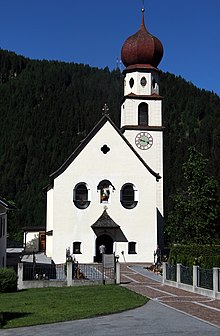Parish church Jerzens
The Roman Catholic parish church of Jerzens is located in the municipality of Jerzens in the Imst district in Tyrol. The parish church consecrated to St. Gotthard belongs to the Deanery Imst in the Diocese of Innsbruck . The church building and the surrounding cemetery are under monument protection .
history
In Jerzens, which could only be reached via mountain paths, there was no church of its own until the 18th century. Services were held five to six times a year in a small chapel on Gotthardsbühel. They were held by a chaplain from Imst . The prospect of a foundation in the amount of 6,000 guilders formed the basis for the establishment of their own church. The chosen building site on a ridge on the edge of the village was the only flat area in the community that was sufficiently large for the project. In addition, the church building would be clearly visible there from all sides.
The construction work carried out under master builder Gallus Gratl from Inzing began in 1736. As early as September 1737, the Brixen auxiliary bishop Ferdinand Joseph Gabriel von Sarnthein was able to consecrate the completed church. The rectory of the parish was built 1,751th The first branch moved in the following year . Soon after, the old chapel on Gotthardsbühel was demolished. Few remains of the chapel's foundations have been preserved.
The furnishings of the church were expanded in the 19th century to include the organ and paintings for three altars. At the turn of the 20th century, painted church windows were installed and a partial renovation was carried out. On the occasion of the 250th anniversary of the church in 1987, a total renovation took place.
architecture
The simple baroque church building facing west is surrounded by a cemetery. The tower on the north side of the choir has a bell storey set off by cornices with a round arched sound window and an octagonal structure with an onion helmet. The delicate architectural painting on the tower is outlined in red. The large dial of the tower clock is below the sound hole . Further small dials that show quarter hours are attached above below the onion helmet. They are crowned with terracotta angels. The main portal on the east facade is covered with copper sheet , which is provided with driving work by Otto Platter from Zams from 1974. In the main fields on the left the coat of arms of Bishop Paulus Rusch from the Diocese of Innsbruck and on the right the coat of arms of Pope Paul VI. shown. A Gotthard figure from the 2nd half of the 18th century stands in a niche above the portal.
The interior of the church shows a four-bay nave, with the fourth bay being built one wall thicker, and a slightly indented choir with a five-eighth end . The choir and nave are vaulted with a barrel with stitch caps. The walls have a pilaster structure and arched windows with foliage bandwork - stucco from the construction period, which were probably created by masters of the Wessobrunn school . In the 19th century, a two-storey, neo-Gothic decorated wooden gallery was built into the first yoke . The church windows have colored ornamental and figural glazing from the second half of the 19th century and around 1900.
The parapet organ built Franz Weber in the third quarter of the 19th century. There is a bell from 1795.
Furnishing
The baroque high altar with recent Baroque additions shows as an altarpiece Gotthard in front of the Madonna, which the painter Caspar Jele created around 1865. The side figures depicting Antonius and Franziskus on the high altar are works by the sculptor Josef Anton Renn from around 1780 . The side altars show Antonius on the left and Johannes Nepomuk on the right, both painted by Caspar Jele in 1863, with the figures of Sebastian and John the Baptist on the left and Barbara and Katharina on the right. The figures come from the workshop of Josef Georg Witwer from the third quarter of the 18th century.
The stuccoed pulpit, made around 1736, bears carved statuettes of the four church fathers. There are two large baroque chandelier angels from the late 17th century. A lecture cross comes from the first half of the 18th century. The station pictures were created at the end of the 18th century.
A late Gothic relief of the Entombment of Christ is attached to the central pilaster on the north wall as a counterpart to the pulpit. It was created by an unknown master from southern Germany around 1520 and is the most important and oldest work of art in the church. The relief is colored and partly gilded. It has been in the parish church since 1911 and was previously kept in the mortuary chapel. According to legend, the relief was thrown into the Inn in the Engadine during the Reformation and pulled out of the river again near Prutz .
literature
- The art monuments of Austria. Dehio Tirol 1980 . Jerzens, parish church St. Gotthard, pp. 376-377.
- Franz Caramelle, Karl Waibl: Jerzens parish church to St. Gotthart . Parish Jerzens, Jerzens 1987.
Web links
Individual evidence
- ↑ a b Franz Caramelle, Karl Waibl: Jerzens parish church to St. Gotthart . Parish Jerzens, Jerzens 1987, pp. 5-6.
- ↑ a b c The art monuments of Austria. Dehio Tirol 1980 . Jerzens, parish church St. Gotthard, pp. 376-377.
- ^ Franz Caramelle, Karl Waibl: Parish Church Jerzens zum St. Gotthart . Parish Jerzens, Jerzens 1987, p. 8.
- ^ Franz Caramelle, Karl Waibl: Parish Church Jerzens zum St. Gotthart . Parish Jerzens, Jerzens 1987, p. 13.
Coordinates: 47 ° 8 ′ 56.8 " N , 10 ° 44 ′ 44.3" E


